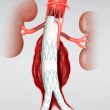Andexanet alfa induces rapid reversion of Xa inhibitor effect in patients with active major bleeding, according to preliminary observations of the ongoing study ANNEXA-4, currently randomizing patients. This work was presented in Rome in the context of the European Society of Cardiology annual meeting, and simultaneously published in the New England Journal of Medicine....
OCT Improves Outcomes in Non ST Elevation ACS
This study presented at the ESC and simultaneously published in Circulation, is the first randomized controlled study to support the use of optical coherence tomography (OCT) in the context of ACS patients. The study randomized 240 patients undergoing non ST elevation acute coronary syndrome to OCT guided PCI (before and after PCI) vs. conventional...
Patients with Plaque Erosion: Management without Stenting
This small study presented at ESC and simultaneously published in the European Heart Journal evaluated patients undergoing acute coronary syndrome caused by plaque erosion identified by optical computed tomography (OCT). The study showed it can be managed with conservative antithrombotic therapy and without stenting. Patients with plaque erosion can receive dual antiplatelet therapy, ticagrelor and aspirin...
A Study on Valve Thrombosis After TAVI
This study, presented in Rome at the European Society of Cardiology Congress 2016 and published simultaneously online in the Journal of the American College of Cardiology (JACC), has identified a post-TAVI valve thrombosis rate of 7% using multidetector computerized tomography (CT). However, the vast majority of cases were completely asymptomatic. Previous studies had shown...
Coronary Perforation in PCI: Associated to Negative Outcomes
Courtesy of Dr. Guillermo Migliaro. Coronary perforation (CP) is a rare but serious complication of percutaneous coronary intervention (PCI) with an estimated incidence of 0.5%. Arterial blood entering the pericardium may cause a rapid elevation of intrapericardial pressure and collapse the right cavities (tamponade) creating hemodynamic compromise. Historically, surgical drainage has been the...
SAPIEN 3: Low One-Year-Mortality in High Risk or Inoperable Patients
In the first PARTNER trial (Placement of Aortic Transcatheter Valves), mortality at one year was 24% for high risk patients and 31% for inoperable patients. A recent report on SAPIEN 3 outcomes at 30 days ─ the last generation balloon expandable valve ─ showed a rather lower adverse events rate. However, additional information at longer...
Beta-Blockers for Revascularized Patients: To Prescribe or Not?
This study examines predictors and outcomes associated with the prescription of beta-blockers at discharge after a successful coronary angioplasty in patients with stable chronic angina WITHOUT prior history of acute myocardial infarction or heart failure. The benefit of beta-blockers in patients with acute myocardial infarction or systolic heart failure is well documented. However, their...
TAAA: Better Outcomes with Renal Fenestration
Courtesy of Dr. Carlos Fava. Thoraco-abdominal aneurysms (TAAA) are a real challenge for surgeons. So far, endovascular repair have rendered good results in these aneurysms, but branch occlusion continues to be their Achilles’ heel”. 449 patients were analyzed, 235 (52%) were treated with branched devices (BEVAR) and 214 (48%) with fenestrated devices (FEVAR)....
Optimal Duration of DAPT: How to Predict Long-Term Events
Courtesy of Dr. Santiago F. Coroleu. Dual antiplatelet therapy (DAPT) with aspirin and clopidogrel after percutaneous coronary intervention (PCI) reduces the risk for coronary thrombotic events (CTEs) at the expense of increasing risk for major bleeding (MB). However, the lack of information to accurately predict the occurrence of each event in out-of-hospital patients under...
Closure Devices vs. Manual Compression
Courtesy of Dr. Guillermo Migliaro. Post PCI major bleeding has been associated with short term mortality in acute coronary syndromes (ACS). Even though studies have shown the transradial approach is safer than the femoral, especially in high risk subgroups ─ mainly STEMI patients ─ the femoral access site continues to be widely used. ...





